Kotido in a bid to save livestock using pour-on drugs
The highly affected areas in Kotido are identified as Kacheri and Rengen sub-counties.
PIC: Pastoralists in Kacheri subcounty in Kotido district join in on the pour-on drug exercise. (Credit: Gladys Kalibbala)
The lives of the Karimojong, who live in north-eastern Uganda, revolve predominantly around livestock herding.
Recently, Frederick Luyimbazi, the commissioner for entomology in the agriculture ministry, traveled to Kotido with other staff to launch the pour-on drug method as a way to save cattle in the dry district.
Most of the livestock in Karamoja region are under threat of getting the Nagana disease due to tsetse fly infestation in the area.
As first-time visitors in Kotido, many in my group were amazed by the big number of animals brought for the pour-on drug exercise at Kacheri sub-county.
But the numbers were more in the past before cattle rustling - and later diseases like Nagana - had intensified, according to Raphael Moding, who heads community animal health workers. Good enough, government's intervention helped deal with the problem of rustling.
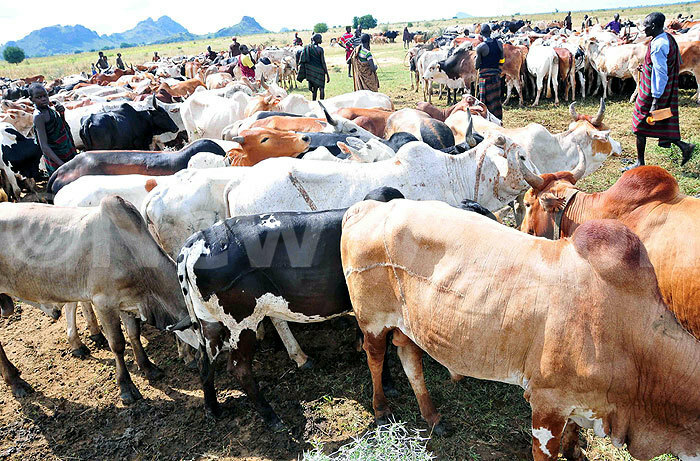
Before, herding was a big challenge as a cattle raid would occur any time, said Dr. Joseph Longoli, who works at the district. "It was so bad that you would find a home which had about 300,000 heads of cattle reduced to none after all the animals were taken," he said.
He added that the estimated cattle population in Kotido between 2006 and 2007 was about 700,000 while today, that statistic has since reduced to between 250,000 and 300,000.

Several herders showed up for the exercise.(Credit: Gladys Kalibbala)
Peter Lokeris, a farmer in Kacheri sub-county, said his family once lost about 200 head of cattle to rustling.
On the day of the launch of the pour-on drug, pastoralists were at the venue as early as 6.00am local time - part because they had to graze their animals before noon.
First, the ‘warriors', as they are called by locals, had to be sensitized about what was going to be done.
"They would hate anyone playing around with their animals so they need sensitization first," said Dr. Longoli.
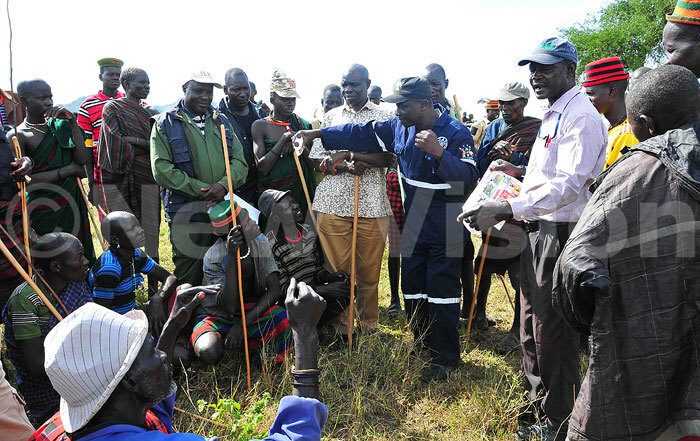
So Luyimbazi and officials had to meet the herders with the help of a translator, Peter Simon Butong, who is the assistant community development officer for Kotido district.
Later, Kotido's resident district commissioner Peter Logiro, chief administrative officer Joshua Mabiya and the LC5 chairman Ambrose Lotukei participated in the pour-on exercise after Luyimbazi handing them the drugs worth 60m donated by the ministry of agriculture, animal industry and fisheries.
The rest of the community joined in after Luyimbazi had given them directions. The drug is poured on the animal's back from head to tail.
"This technique is the most appropriate for the emergency interventions against tsetse flies in Karamoja. The community doesn't need to spend on a pump or water since it's a ready to use application," he said.
Luyimbazi advised that this application be used once a month, targeting a minimum of at least four applications. This method not only kills tsetse flies but also rids the animals of ticks, stomoxys (Kawawa), Tabanids (Ebiruma mbogo) and many others.
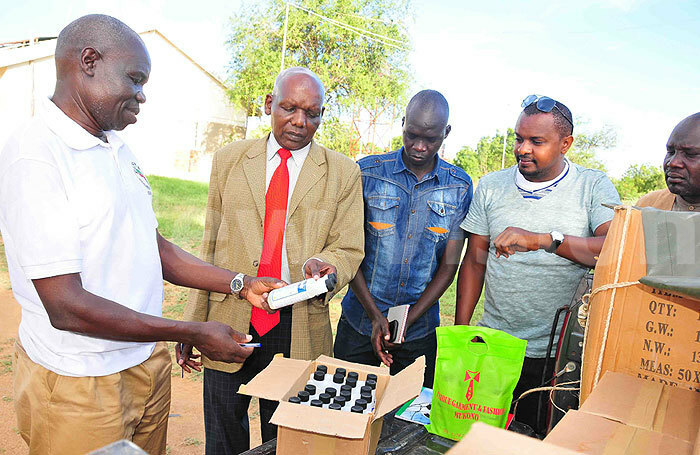
From left, Luyimbazi, Kotido CAO Joshua Mabiya and other officials check out the drugs donated by the agriculture ministry. (Credit: Gladys Kalibbala)
State of tsetse flies in Kotido
In a recent survey by entomologists from the agriculture ministries, over 900 tsetse flies were caught in a trap just three days after setting it in Kacheri sub-county.
"It's very unfortunate to find that areas like Karamoja, which were previously considered low-risk, have now been confirmed to have the Nagana disease with prevalence rates of up to 30% in some areas," said Luyimbazi.
Tsetse flies transmit Nagana in animals and Sleeping sickness in human.
The highly affected areas in Kotido were identified as Kacheri and Rengen sub-counties while reports from the agriculture ministry indicate that tsetse fly infestation is threatening half of the national herd while in Uganda about 70% of the land surface is tsetse fly-infested.
Kotido RDC Peter Logiro (pictured below) said that due to insufficient rainfall, farmers are forced to go far in search of pasture and end up where there is greener pasture in the green belt. And according to Luyimbazi, such fertile vegetation attracts tsetse flies and in this way they end up attacking the animals.
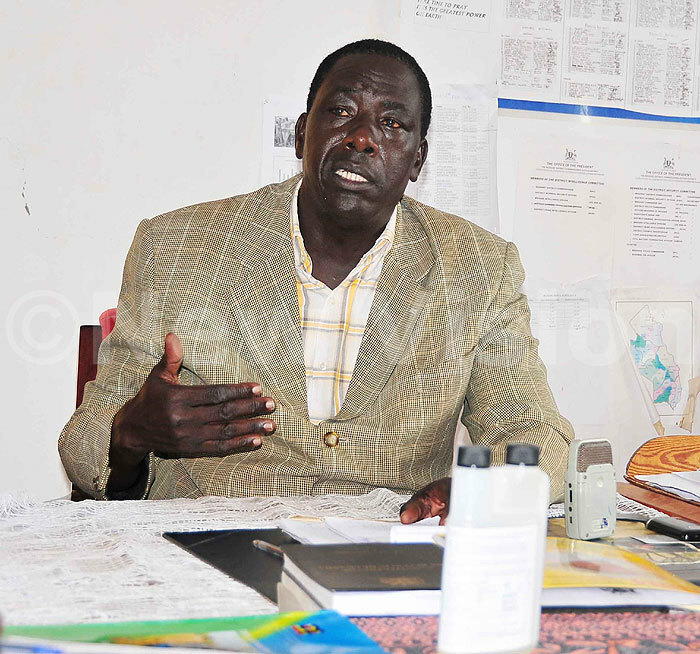
‘Aerial spraying needed'
Luyimbazi explained that Karamoja is one of the tsetse fly-infested areas of Uganda where the main tsetse fly species are Glossina morsitans sub morsitans and Glossina longipennis, known to be important vectors for animal trypanosomiasis.
He said that in such a remote and inaccessible area like Karamoja, with limited human involvement due to wild animals in the nearby national parks, the lasting solution will be aerial spraying.
"This is a non-residual, bio-degradable insecticide in form of an aerosol targeting adult tsetse flies. It's known to be very effective and has the ability to cover large areas of the tsetse fly-infected country very quickly."
The technique will require an environmental impact assessment which takes some time and so, Luyimbazi maintains that the required emergency for Karamoja cannot wait anymore.
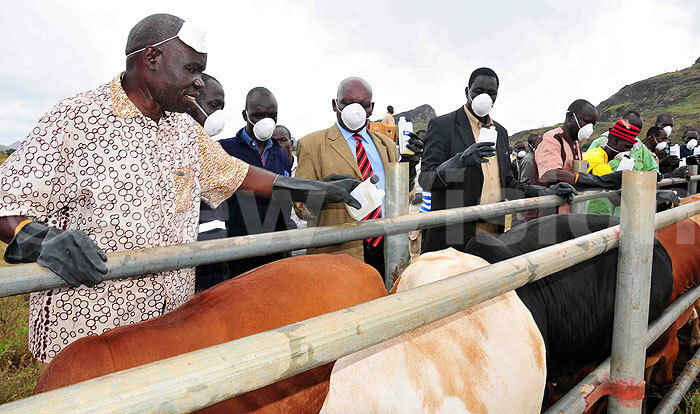
From left, Fredrick Luyimbazi, CAO Joshua Mabiya (with tie), RDC Peter Logiro (with black coat) RDC for Kotido, LC5 Ambrose Lotukei and others took part in the exercise. (Credit: Gladys Kalibbala)
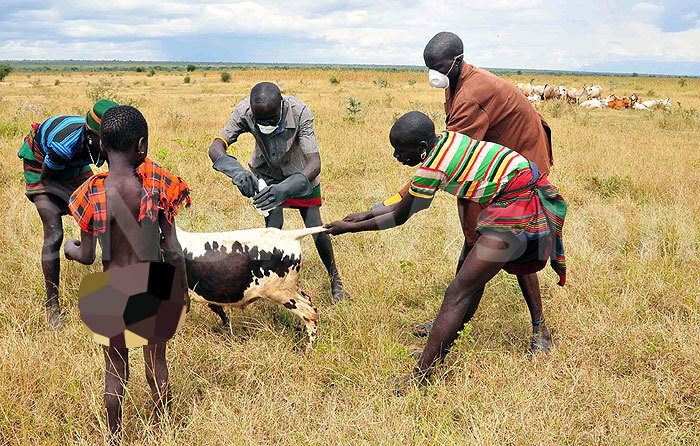
After being given directions on how to use the pour-on drug, the pastoralists got down to some work. (Credit: Gladys Kalibbala)
WHAT THEY SAY
Dr. Henry Mulondo, district veterinary officer for Kotido:
"Nagana is one of the most significant constraints to livestock production in Uganda. We need to sensitize our community more so that they stop using under-doses while treating their animals. They decry expensive drugs and end up buying small quantities where we may face some drugs becoming resistant to killing ticks and other diseases. Government should also come in to ascertain that the drugs sold are not fake."
Joshua Mabiya, Kotido chief administrative officer:
"The people here cannot survive without cows but they need to know that it's also important to treat them and keep them from diseases. We will embark on community-based approaches to help bring them on board. The community should understand that it is important to sell off some of their cows in order to treat the rest of their herds."